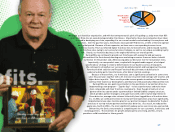Sonic 2004 Annual Report Download - page 19
Download and view the complete annual report
Please find page 19 of the 2004 Sonic annual report below. You can navigate through the pages in the report by either clicking on the pages listed below, or by using the keyword search tool below to find specific information within the annual report.
under our line of credit, and seller-provided financing for the Colorado acquisition.
During fiscal year 2004, we purchased the real estate for 13 of the 45 newly constructed
and acquired drive-ins. We also sold real estate for cash in the amount of $8.8 million
relating to drive-ins previously sold to franchisees.
We plan capital expenditures of approximately $60 to $70 million in fiscal year 2005,
excluding potential acquisitions and share repurchases. These capital expenditures
primarily relate to the development of additional Partner Drive-Ins, stall additions,
relocations of older drive-ins, store equipment and point of sale system upgrades, and
enhancements to existing financial and operating information systems. We expect to
fund these capital expenditures through cash flow from operations and borrowings
under our existing line of credit.
We entered into an agreement with certain franchisees during fiscal year 2003,which
provides them with the option to sell 50 drive-ins to us anytime during the period
commencing January 1, 2004 and ending June 30, 2005. We estimate that the cost of the
acquisition, if it were to occur, would be in the range of $32 to $38 million and anticipate
that the acquisition would be funded through operating cash flows and borrowings
under our existing line of credit.
As of August 31, 2004, our total cash balance of $8.0 million reflected the impact of
the cash generated from operating activities,borrowing activity, and capital expenditures
mentioned above. We believe that existing cash and funds generated from operations, as
well as borrowings under the line of credit, will meet our needs for the foreseeable future.
Contractual Obligations and Commitments
In the normal course of business, Sonic enters into purchase contracts, lease
agreements and borrowing arrangements. Our commitments and obligations as of
August 31, 2004 are summarized in the following table:
Payments Due by Period
(In thousands)
Less than 1 – 3 3 – 5 More than
Total 1 Year Years Years 5 Years
Contractual Obligations
Long-term debt $ 82,169 $ 3,495 $ 61,478 $ 7,544 $ 9,652
Capital leases 63,930 5,011 9,810 9,488 39,621
Operating leases 105,617 9,329 18,586 17,836 59,866
Vendor purchase
agreements 1,660 1,660 – – –
Total $ 253,376 $ 19,495 $ 89,874 $ 34,868 $109,139
Impact of Inflation
Though increases in labor, food or other operating costs could adversely affect our
operations, we do not believe that inflation has had a material effect on income during
the past several years.
Seasonality
We do not expect seasonality to affect our operations in a materially adverse manner.
Our results during the second fiscal quarter (the months of December, January and
February) generally are lower than other quarters because of the climate of the locations
of a number of Partner and Franchise Drive-Ins.
Critical Accounting Policies and Estimates
The Consolidated Financial Statements and Notes to Consolidated Financial
Statements included in this document contain information that is pertinent to
management's discussion and analysis. The preparation of financial statements in
conformity with generally accepted accounting principles requires management to use
its judgment to make estimates and assumptions that affect the reported amounts of
assets and liabilities and disclosure of contingent assets and liabilities.These assumptions
and estimates could have a material effect on our financial statements. We evaluate our
assumptions and estimates on an ongoing basis using historical experience and various
other factors that are believed to be relevant under the circumstances. Actual results may
differ from these estimates under different assumptions or conditions.
We annually review our financial reporting and disclosure practices and accounting
policies to ensure that our financial reporting and disclosures provide accurate and
transparent information relative to the current economic and business environment. We
believe that of our significant accounting policies (see Note 1 of Notes to Consolidated
Financial Statements), the following policies involve a higher degree of risk, judgment
and/or complexity.
Impairment of Long-Lived Assets.We review each drive-in for impairment when
events or circumstances indicate it might be impaired. We test for impairment using
historical cash flows and other relevant facts and circumstances as the primary basis for
our estimates of future cash flows. This process requires the use of estimates and
assumptions, which are subject to a high degree of judgment. In addition, at least
annually,we assess the recoverability of goodwill and other intangible assets related to
our brand and drive-ins. These impairment tests require us to estimate fair values of our
brand and our drive-ins by making assumptions regarding future cash flows and other
factors.If these assumptions change in the future, we may be required to record
impairment charges for these assets.
Management's Discussion and Analysis of Financial Condition and Results of Operations
p.17
























